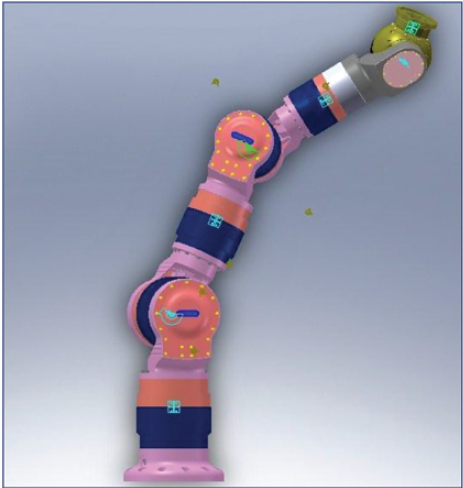| Thesis Student | Omar W. Maaroof |
| Program | MSc Thesis Project |
| Status | Completed |

Redundancy in general provides space for optimization in robotics. Redundancy can be defined as sensor/actuator redundancy or kinematic redundancy. The redundancy considered in this thesis is the kinematic redundancy where the total degrees-of-freedom of the robot is more than the total degrees-of-freedom required to execute the task. This provides infinite number of solutions to perform the same task, thus, various subtasks can be carried out during the main-task execution. In the last 5-10 years, various international companies configured kinematically redundant mechanisms by adding extra actuation systems and were able to reach 5-6g acceleration levels. Integrated parallel mechanisms, with small workspace that can move along x and y direction (micro mechnaism), to the main construction that can move along the X and Y directions (macro mechanism) which can be named as a hybrid structure. As a result of this, in relatively small sized motions, they could reach higher accelerations because they are exposed to smaller inertial loads.
This work utilizes the property of self-motion for kinematically redundant robot manipulators by designing the general subtask controller that controls the joint motion in the null-space of the Jacobian matrix. The general subtask controller is implemented for various subtasks in this thesis. Minimizing the total joint motion, singularity avoidance, posture optimization which include maximizing/minimizing for static impact force objectives and static and moving obstacle (point to point) collision avoidance are the subtasks considered in this thesis.
New control architecture is developed to accomplish both the main-task and the previously mentioned subtasks. In this architecture, objective function for each subtask is formed. Then, the gradient of the objective function is used in the subtask controller to execute subtask objective while tracking a given end-effector trajectory which is called main-task.
The SCHUNK LWA4-Arm robot arm with seven degrees-of-freedom is developed first in SolidWorks® as a computer-aided-design (CAD) model. Then, the CAD model is converted to MATLAB® Simulink model using SimMechanics CAD translator to be used in the simulation tests of the controller. Kinematics and dynamics equations of the robot are derived to be used in the controllers. Simulation test results are presented for the kinematically redundant robot manipulator operating in 3D space carrying out the main-task and the selected subtasks for this study. The simulation test results indicate that the developed controller’s performance is successful for all the main-task and subtask objectives.
[1] M. İ. C. Dede, O. W. Maaroof and E. Tatlicioglu, ” A New Objective Function for Obstacle Avoidance by Redundant Service Robot Arms,” IInternational Journal of Advanced Robotic Systems, 2016, 13:48. (DOI: 10.5772/62471)
[1] O. Maaroof, E. Gezgin, and M. İ. C. Dede, “General subtask controller for redundant robot manipulators,” 12th IEEE Int. Conf. on Control, Automation, Jeju Island, Korea, October 17-21, 2012.
[2] O. W. Maaroof and M. İ. C. Dede,”Physical Human-Robot Interaction: Increasing Safety by Robot Arm’s Posture Optimization,”ROMANSY 21 – Robot Design, Dynamics and Control, Vincenzo Parenti-Castelli, Werner Schiehlen(Eds.), Volume 569, pp. 329-337, Springer, Dordrecht, The Netherlands, 2016. (DOI: 10.1007/978-3-319-33714-2_37).
[1] O. W. N. Maaroof, “Self-Motion Control of Kinematically Redundant Robot Manipulators,” MSc Thesis, Izmir Institute of Technology, 2012.
